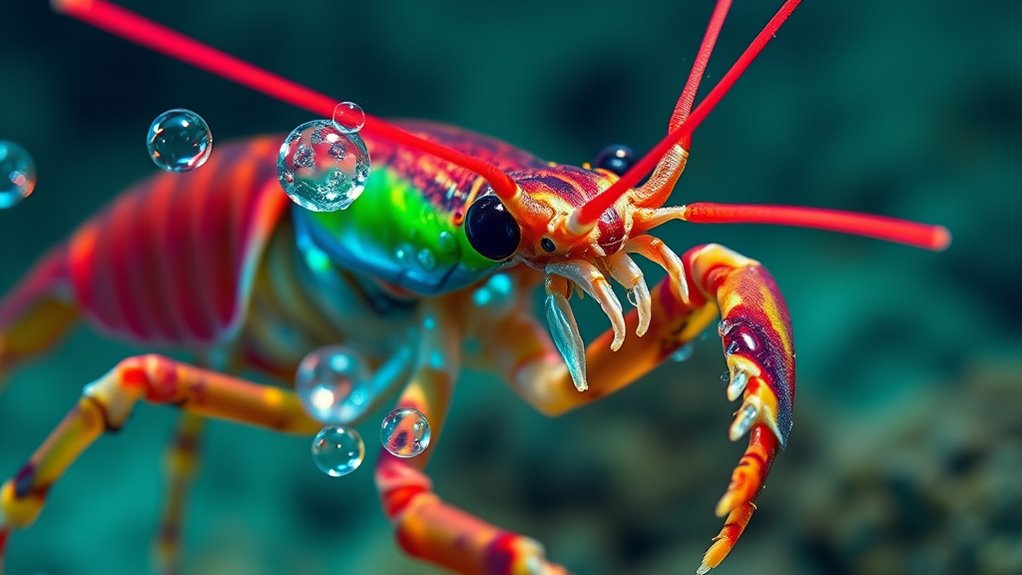The mantis shrimp perceives a hidden world of colors beyond what humans can see. It detects ultraviolet light and polarized signals, giving it a vivid, complex view of its environment. This extraordinary vision helps it navigate, hunt, and communicate in vibrant coral reefs. If you’re curious about these unseen colors and how they shape life underwater, keep exploring to discover the secrets behind this astonishing sensory ability.
Key Takeaways
- Mantis shrimp perceive ultraviolet light and polarized wavelengths invisible to humans.
- They detect bioluminescent signals and subtle color shifts used for communication and camouflage.
- Their advanced visual system reveals a hidden spectrum of vibrant, unseen colors in marine environments.
- These secret colors help them hunt, navigate, and interact in complex underwater habitats.
- Human eyes cannot see these colors, but mantis shrimp’s vision unlocks this invisible realm.
The Unique Vision of Mantis Shrimp
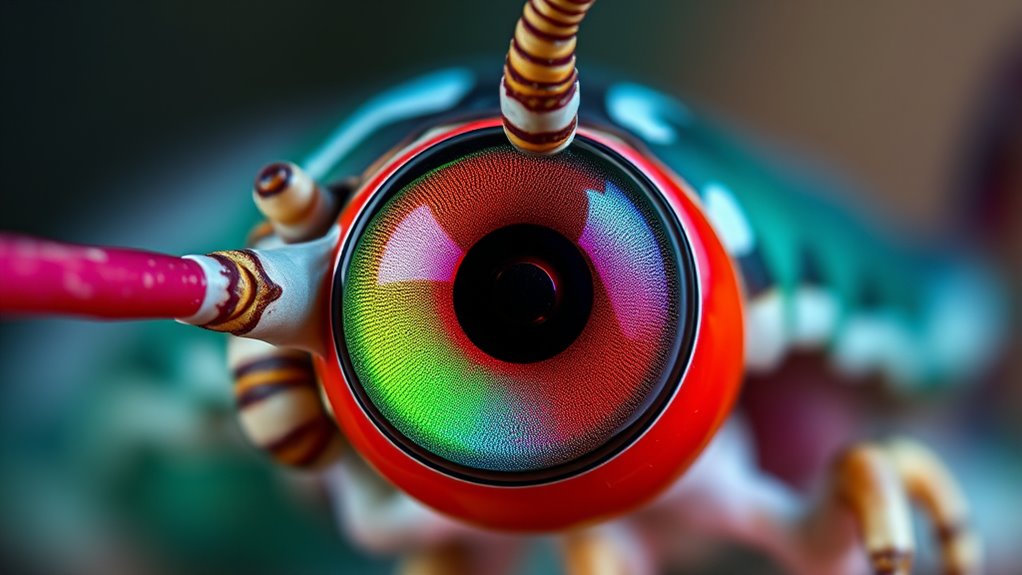
Mantis shrimp have an extraordinary way of seeing the world that far surpasses human vision. Their color perception is incredibly advanced, allowing them to detect a spectrum of colors humans can’t even imagine. This remarkable visual adaptation stems from their complex eyes, which contain dozens of photoreceptors—more than any other creature. Unlike us, they don’t just see in broad colors but perceive subtle hues and polarized light, giving them a vivid, detailed view of their surroundings. This specialized vision isn’t static; it’s adaptable, enabling them to adjust to different lighting conditions and environments. Their unique visual system gives them a distinct advantage, helping them hunt, communicate, and navigate in ways we’re only beginning to understand.
How Mantis Shrimp Detects Colors Beyond Human Perception
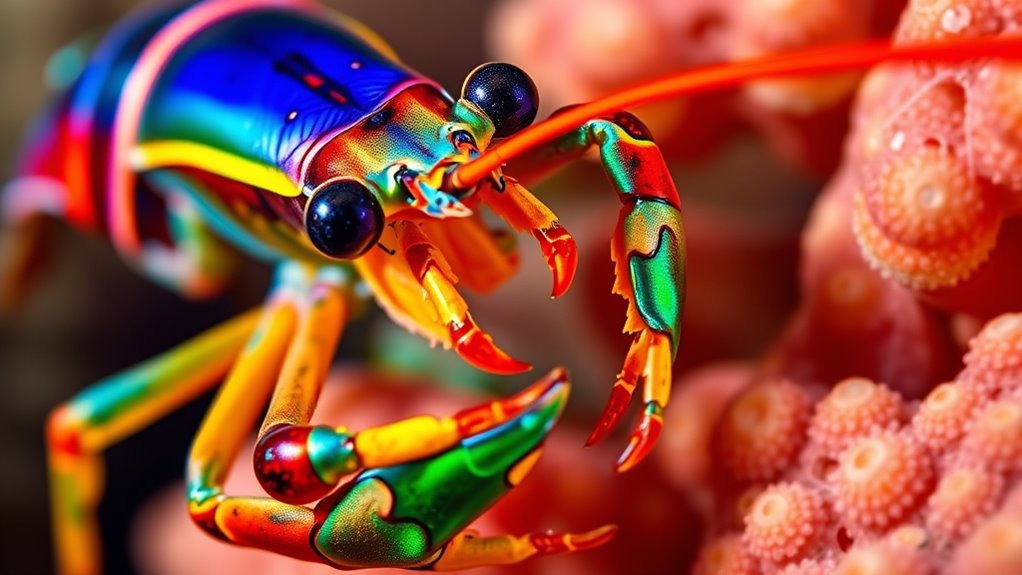
Thanks to their complex eyes, mantis shrimp can perceive a range of colors far beyond what humans can see. Their eyes contain specialized photoreceptors that detect ultraviolet light and polarized colors, giving them an extraordinary visual ability. This unique perception helps them navigate their vibrant coral habitats and find prey. Understanding how mantis shrimp see beyond human perception can impact marine conservation efforts by highlighting the importance of preserving these colorful ecosystems. Their ability to detect hidden signals also inspires artists and scientists to explore new ways of visualizing color. By studying their visual system, we gain insight into nature’s hidden spectrums, fostering appreciation and protection of marine biodiversity. Their extraordinary vision reminds us of the richness that exists beyond our limited perception. Additionally, their advanced visual system demonstrates the remarkable diversity of sensory adaptations in the animal kingdom. Recognizing these unique adaptations can also influence the development of innovative visual technologies inspired by nature’s designs. Moreover, ongoing research into their eyes continues to uncover new biological mechanisms that could revolutionize optical science and technology. This research underscores the importance of biomimicry in advancing human technology by leveraging biological innovations.
The Science Behind Hidden Spectrums of Light
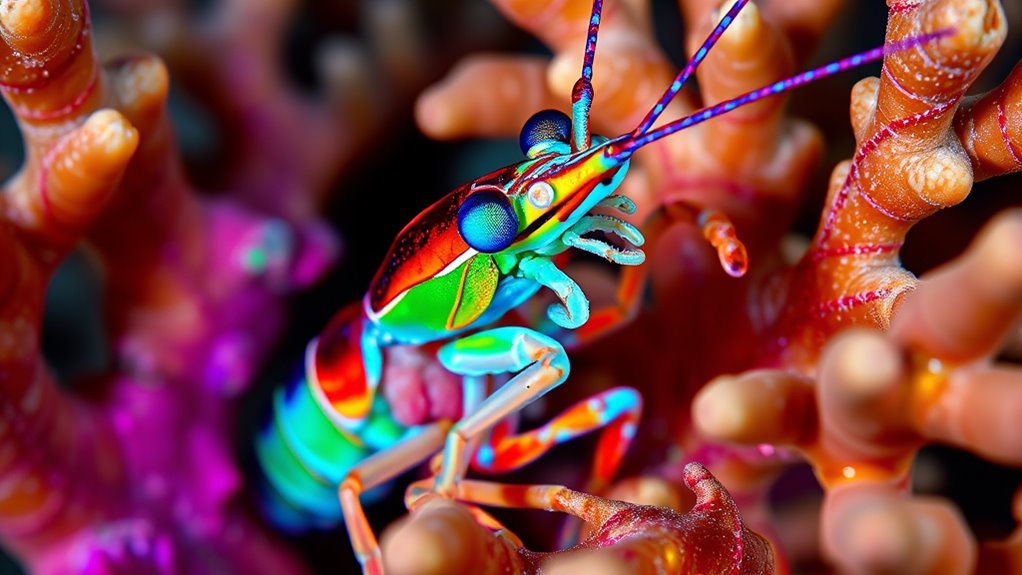
The hidden spectrums of light beyond human vision stem from the way specialized photoreceptors in certain creatures’ eyes detect wavelengths that we cannot see. In marine biology, researchers study these extraordinary visual systems to understand how animals perceive their environment. These photoreceptors can detect ultraviolet, polarized, or infrared light, expanding their perception far beyond human capabilities. Optical engineering plays a *pivotal* role in uncovering these hidden spectrums by developing advanced imaging tools and sensors that simulate or analyze these wavelengths. By understanding how these creatures see, scientists can design better underwater cameras and vision systems. This interdisciplinary approach highlights the importance of biological adaptation in expanding our understanding of the natural world‘s complexity. Additionally, advances in regional legal resources support marine research efforts by providing legal frameworks and protections for scientific exploration. This knowledge reveals the vast complexity of light and color, showing that our visual experience is just a small part of what truly exists in the natural world.
Evolutionary Advantages of Extraordinary Color Vision
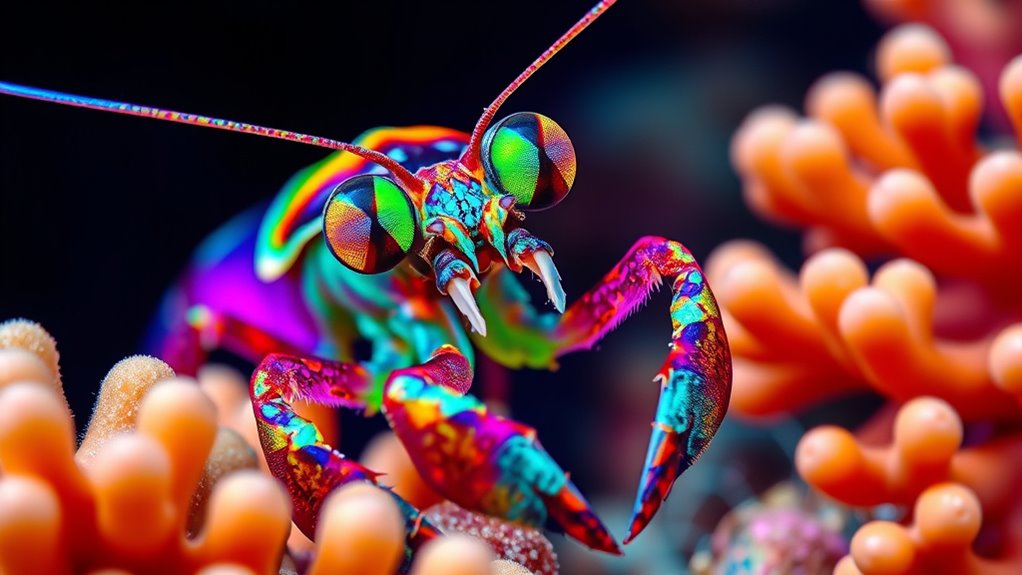
Your extraordinary color vision provides a clear edge in spotting predators early, keeping you safe. It also helps you interpret complex mating signals that others might miss, boosting your chances of reproduction. Additionally, this heightened perception improves your ability to navigate and understand your environment more effectively. Understanding visual perception mechanisms can further enhance insights into how such extraordinary vision evolved, by revealing the biological adaptations that support this remarkable sensory capability. Exploring how sensory processing influences perception might shed light on the development of such specialized vision in mantis shrimp. Moreover, examining indoor gardening tools can inspire innovative ways to cultivate and showcase extraordinary plant displays, reflecting the creativity found in nature’s adaptations.
Enhanced Predator Detection
Extraordinary color vision offers a crucial advantage in detecting predators early, giving you a better chance to respond and escape. With this keen perception, you can spot subtle cues like bioluminescent communication from prey or predators, revealing hidden threats in dark waters. You also gain an edge in recognizing predator camouflage, which often disguises foes by blending into the environment. This enhanced visual ability allows you to pick up on faint color differences and patterns invisible to others. As a result, you’re better equipped to avoid danger before it gets too close. Your ability to detect these subtle signals and camouflaged predators improves survival odds markedly. This evolutionary trait ensures you stay one step ahead, making you more adept at navigating the dangers of your environment. This remarkable visual skill enables mantis shrimp to thrive in complex habitats and avoid predators effectively, highlighting the importance of visual perception in survival strategies.
Complex Mating Signals
Have you ever wondered how some animals attract mates with dazzling displays of color? Mantis shrimp use their extraordinary vision to create complex mating signals during their rituals. These vibrant signals stand out, even in murky waters, making it easier for potential mates to recognize quality partners. Their ability to see a broader spectrum of colors allows them to craft intricate displays that convey strength and health. This advanced visual perception enables mantis shrimp to perform visual signaling that effectively communicates their fitness. Here’s how their dazzling displays compare:
| Signal Type | Visual Effect | Purpose |
|---|---|---|
| Bright Color Flashes | Attracts attention quickly | Stand out among rivals |
| Subtle Color Shifts | Indicates maturity or status | Signal readiness to mate |
| Pattern Variations | Demonstrates genetic fitness | Impress potential mates |
| Dynamic Displays | Keeps rivals guessing | Secure reproductive success |
Furthermore, their ability to perceive ultraviolet light enhances the complexity of their signals, making them even more distinctive in their environment.
Improved Environmental Navigation
Because mantis shrimp see a broader spectrum of colors than many other animals, they can navigate complex underwater environments more effectively. Their extraordinary vision allows them to detect subtle differences in color and polarization, essential for recognizing safe pathways and avoiding predators within diverse underwater ecosystems. In marine biology, this enhanced perception gives mantis shrimp a significant advantage, helping them interpret their surroundings with precision. Their ability to distinguish between various textures and signals ensures they can find food, mates, and shelter efficiently. This superior environmental navigation minimizes risks and optimizes survival chances. By understanding these visual capabilities, we gain insight into how mantis shrimp thrive in their habitats, showcasing the evolutionary benefits of their extraordinary color vision in maintaining their role within underwater ecosystems. Additionally, their ability to perceive polarized light enhances their capacity to detect prey and predators more effectively visual perception. Their complex visual system is a prime example of how adaptive evolution can lead to extraordinary sensory adaptations in the animal kingdom.
Implications for Human Technology and Perception
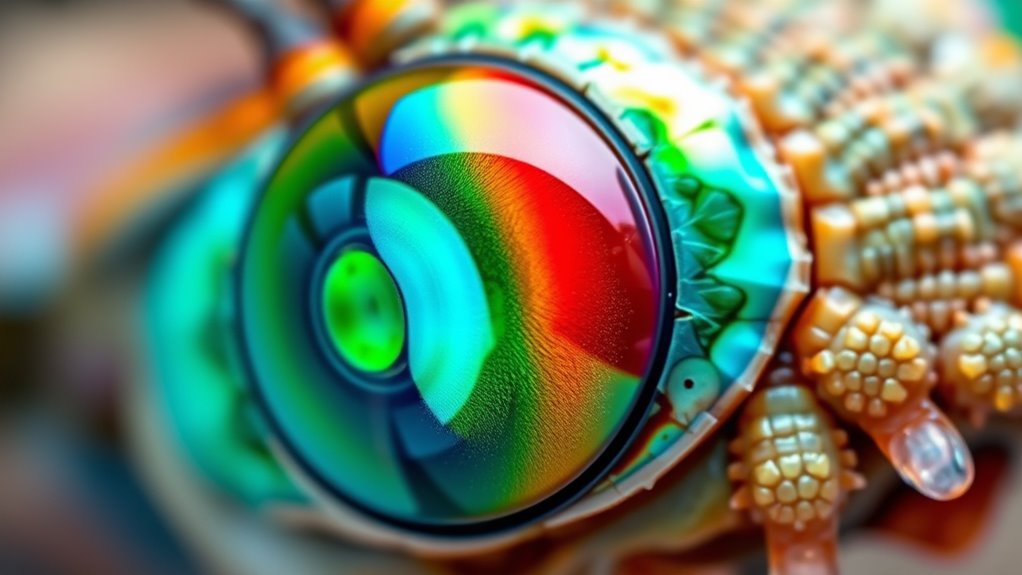
Advances in optical sensors could let you detect colors beyond human perception, opening new possibilities for imaging and data collection. Improved visual displays might show information in ways that are more intuitive and immersive than ever before. Meanwhile, better signal processing can help interpret complex color data quickly, transforming how you interact with technology daily. Recognizing advanced tuning techniques can enhance shopping efficiency and ensure timely purchases. Additionally, integrating sound design principles into visual interfaces can create more engaging and responsive user experiences. Understanding color perception can also inform the development of more effective visual communication tools.
Advancing Optical Sensors
How are emerging optical sensors transforming human technology and perception? These innovations enable us to detect signals like bioluminescent signaling, which was once invisible to the human eye. Advanced sensors improve underwater light adaptation, allowing us to see in extreme darkness and detect subtle changes in light patterns beneath the surface. This technology enhances underwater exploration, environmental monitoring, and security systems. By mimicking biological systems, sensors now pick up a broader spectrum of light, revealing details previously hidden. This progress pushes the boundaries of human perception, making us more aware of the unseen world around us. Additionally, bioluminescent signaling can be detected more effectively with these sensors, opening new avenues for scientific discovery. As optical sensors continue to evolve, they promise to revolutionize how we interact with and understand environments beyond our natural capabilities.
Enhancing Visual Displays
Emerging optical sensors are now redefining visual displays, allowing for more vivid, dynamic, and immersive experiences. By harnessing advanced color filtration techniques, designers can produce displays with richer, more accurate colors that surpass traditional screens. These sensors improve visual acuity, enabling sharper images and finer detail recognition, creating a more lifelike experience. Incorporating insights from mantis shrimp’s unique vision, technology can simulate a broader spectrum of colors, making visuals more vibrant and engaging. This progress enhances everything from virtual reality to high-definition screens, making digital content more realistic and enthralling. As these innovations evolve, you’ll notice displays that better mimic natural vision, transforming how you perceive and interact with digital environments. This leap forward opens new possibilities for entertainment, communication, and immersive experiences. Additionally, ongoing research into vetted visual technologies ensures these advancements are both innovative and reliable. Furthermore, understanding the mantis shrimp’s complex color perception can inspire the development of even more advanced optical sensors, pushing the boundaries of human visual experience.
Improving Signal Processing
As signal processing techniques improve, they markedly enhance the way digital devices interpret and deliver visual information. By understanding neural coding, engineers can design systems that more accurately mimic biological vision, improving clarity and detail. Signal amplification plays a vital role, strengthening weak signals for clearer transmission and reducing noise. These advancements enable devices like cameras and displays to process complex visual data more efficiently, resulting in sharper images and more accurate color reproduction. Better signal processing also allows for faster response times and improved low-light performance. For humans, this means more immersive virtual experiences and enhanced visual aids. Furthermore, a comprehensive understanding of cookie categories helps optimize user experiences and data collection practices. Additionally, innovations in celebrity lifestyle insights can inspire new technological applications in visual processing. The development of visual perception models based on biological systems contributes to these improvements by providing insights into how nature processes complex visual stimuli. Insights from neural coding research continue to drive innovations that bring digital visual systems closer to the extraordinary capabilities observed in mantis shrimp, opening new frontiers in perception and digital communication.
Exploring the Mysteries of the Invisible Color Realm
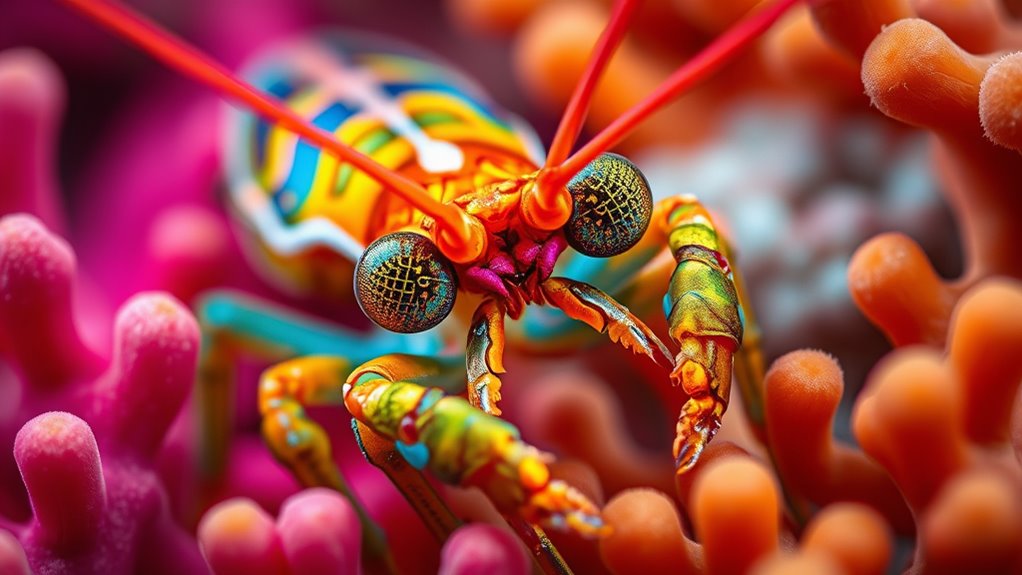
While we are accustomed to seeing colors that fill our everyday lives, there exists a mysterious domain beyond our perception—colors that are invisible to the naked eye. Scientists explore this invisible color realm through techniques like color spectrum mapping, which reveals hidden wavelengths outside human vision. Bioluminescent displays in deep-sea creatures, for example, showcase flashes of light that contain colors we can’t see ourselves, yet can be detected and analyzed scientifically. These invisible colors may hold clues to understanding how animals communicate or camouflage themselves in complex environments. As researchers continue to map the full spectrum of light, they uncover a hidden world that challenges our understanding of color, revealing that the universe is far more vibrant and mysterious than our eyes alone can perceive.
Frequently Asked Questions
Can Humans Ever See the Secret Color Mantis Shrimp Perceives?
You wonder if humans can ever see the secret color mantis shrimp perceives. While our color perception limitations prevent us from directly experiencing bioluminescent signals or ultra-violet hues, scientists are developing advanced imaging techniques to reveal these hidden colors. Although we might not see them with naked eyes, technology could help us understand and visualize these secret colors, expanding our perception of the vibrant world mantis shrimp already perceives.
How Do Mantis Shrimp Process and Interpret Their Complex Visual Information?
You might wonder how mantis shrimp process their complex visual information. They use advanced neural mechanisms that enable rapid visual processing, allowing them to analyze multiple color channels simultaneously. Their eyes contain specialized photoreceptors, which send signals to highly developed neural pathways. This system helps them interpret intricate visual cues from their environment, giving them extraordinary perception skills that are far beyond human capabilities.
Are There Other Animals With Similarly Hidden or Advanced Color Perception?
Think of the animal kingdom as a hidden gallery of visual marvels. Besides mantis shrimp, certain cephalopods like octopuses and cuttlefish possess extraordinary color perception, aiding in marine camouflage and bioluminescent signaling. They can change color and pattern rapidly, communicating and hiding from predators. Your curiosity reveals that other creatures also see beyond our spectrum, using advanced vision to navigate their vibrant, secret worlds underwater.
What Technological Innovations Could Mimic Mantis Shrimp’S Visual Capabilities?
You could develop biomimicry innovations that replicate mantis shrimp’s incredible vision by advancing sensory technology. By studying their complex eyes, scientists can create cameras and sensors that detect a broader spectrum of light, including polarized and ultraviolet waves. These innovations could improve imaging, underwater exploration, and even medical diagnostics, allowing humans to see in ways previously thought impossible. Mimicking such natural systems opens new frontiers in optical and sensory technology.
Does This Invisible Color Have Potential Practical Applications in Human Design?
Imagine revealing a secret garden of colors invisible to the naked eye—that’s what this hidden hue offers. This color’s potential for human design is exciting, as it could fuel biomimicry innovations and sensory enhancement. You might develop advanced displays or security features that utilize these unseen shades, creating a new dimension of communication and interaction. Embracing this invisible color could revolutionize how you perceive and interact with your environment.
Conclusion
You’ve just glimpsed a world beyond your senses, where mantis shrimp see colors you can’t even imagine. Their extraordinary vision reveals that there’s always more beneath the surface, waiting to be discovered. It’s a reminder that sometimes, what we don’t see can be just as powerful as what’s right in front of us. Keep your eyes open and stay curious—there’s a whole universe of hidden wonders out there, just waiting to be uncovered.
